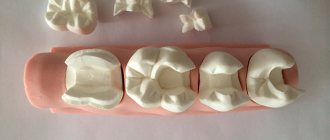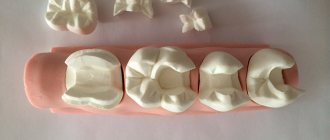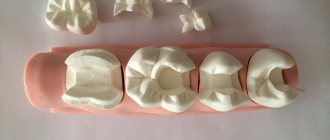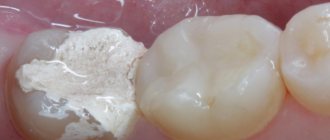Stump tab for a crown: what is it?
Stump inlays in dentistry are a special type of solid-cast structures that are used in the process of restoration of heavily damaged units. If there is significant tissue destruction, a conventional pin cannot be used, since its installation can create excessive stress on the tooth root, which can cause it to crack, which can lead to subsequent removal of the tooth unit. Under such circumstances, the stump tab is installed.
A stump inlay is placed directly into the root canal and this allows you to properly strengthen the tooth in order to subsequently qualitatively restore the unit by installing a crown on it. Externally, the inlay resembles a dental stump that has undergone a grinding procedure and that is why it has the name “stump inlay.”
What are they made from?
Modern dentistry uses hard, elastic, thermoplastic and modeling substances. What is required for a jaw impression depends on the condition of the patient's jaw and oral cavity. The solid material is gypsum. Its use occurs in rare cases, since it is removed in parts, which are later folded to form a complete cast. Plaster is used if the chewing elements are too mobile. Its replacement is dentol. It is more expensive, but does not break during removal.
The elastic material is alginate and silicone. Such substances are capable of accurately conveying the condition of the jaw, but are subject to rapid deformation. This means that a prosthesis needs to be made urgently. The use of alginate and silicone is necessary for:
- Inlays in clasp orthodontic construction.
- Stamped crown.
- Complete removable denture.
Thermoplastics consist of a material that softens when heated and is able to take the desired shape. They are used more than once. The downside is deformation during removal. The composition of the modeling product includes paraffin, wax, and stearin. The result is a detailed print. But it is necessary to control that the finished print is not exposed to high temperatures. Otherwise it will soften.
Indications and contraindications
Indications for the use of a stump inlay as a prosthetic method are severe destruction of dentin, in which its restoration is impossible with composite materials and pins. The crown on the core tab will hold quite firmly and at the same time not exert strong pressure on the root. Stump inlays are also used to create a high-quality foundation for the installation of dental bridges.
However, like any other medical procedure, the installation of stump inlays has not only indications, but also a number of restrictions on its implementation. These restrictions include:
- The patient has an individual allergic reaction to the material used to make the stump insert.
- Identification during examination of cysts and other formations in the root system.
- Excessively thin dental walls, abnormally short roots of the dental unit.
The procedure for installing a stump inlay for periodontitis, as well as poorly treated dental canals, is not carried out. Depending on the individual characteristics of the case, the dentist may offer the patient different types of stump inlays for installation. The cost of the stump tab and tooth restoration services using it will depend on the type of structure.
Stump tab
from 5400 rub. More about prices
We have been working since 1994
we are one of the first to open private dentistry in Moscow
Best materials
only new and modern equipment for dental treatment
Free
consultation with a dentist
Payment options
- cash
- plastic cards
- cashless payments
Doctors' experience
- with great experience
- graduated
- conference participants
Types of stump inlays by design
Based on their design, a distinction is made between solid and collapsible stump inlays. Cast core inlays are made by a dental technician in the laboratory and consist of two main parts - a root and a coronal element. Most often, a microprosthesis obtained by casting is used to restore teeth that have 1-2 roots. Collapsible structures are made of metal alloys and are designed for the restoration of dental units with a large number of roots.
This stump tab is equipped with special fixing elements that are pulled out from its base. The legs are needed to secure the structure as firmly as possible in the canal of the tooth, the walls of which have undergone complete destruction. It is impossible to remove a collapsible type stump inlay after its installation.
Types of stump inlays according to production material
Various materials can be used in the manufacture of stump pin inlays. Designs can be produced:
1. Made from zirconium dioxide. A stump inlay made of zirconium dioxide will not only be characterized by increased strength and reliability, but will also have high aesthetics. Most often, zirconium core inlays are used to restore teeth that fall within the smile area.
2. Composite core inlays are created on the basis of a pin and a composite based on dental porcelain (ceramics). This design looks aesthetically pleasing, but it has the lowest strength indicators in comparison with stump spacers made of metal and zirconium.
A separate type of structure is stump inlays made of metal. A variety of metals, as well as their alloys, can be used to create metal inlays. The price of a tooth stump will depend on the type of metals used in the alloy.
Differences from veneers - and is it possible to put inlays on incisors and canines?
If we take into account the materials for manufacturing, then both veneers and inlays are, in principle, identical. Besides metal, metal veneers would look too shocking. Although some musical performers wear grills - removable analogues of veneers made of precious metals and stones. Some patients also call veneers ceramic inlays for the front teeth. But here the term “overlays” is still closer, because Veneers are applied to the tooth surface rather than inserted into a cavity.
The main difference is that any veneers are installed only on the anterior side of the frontal zone (incisors, canines and sometimes the first premolar) and serve only to give the smile high aesthetics. You cannot bite off hard food with veneers. And inlays are installed only on the chewing areas of the rows (premolars and molars), and on any side - the chewing surface, the lateral one. And you can chew any food with your teeth using these microprostheses.
Don't know what type of prosthetics to choose?
We will help in the selection, advise where to read more information and compare types of prosthetics.
Consultation with an orthopedic doctor in Moscow clinics is free! Call now or request a call
Working hours: from 9:00 to 21:00 - seven days a week
Features of the manufacturing and installation process of stump inlays
The process of manufacturing a stump tab and its subsequent installation is divided into several main stages:
1. The dentist carefully prepares both the roots and walls of the tooth for the installation of a core inlay. The tooth is ground down and a special base for the structure is formed in it. An impression of the patient's teeth is then made.
2. Based on the impression taken, the dental technician makes a model of the core inlay from plaster, after which the structure itself is modeled on a computer.
3. The stump inlay is made by casting or milling. The production technology will depend both on the type of structure chosen for the procedure and on its material of manufacture.
At the final stage, the finished stump inlay is tried on the patient, after which the doctor fixes the structure in the oral cavity. The dental core is fixed with special dental cement.
What kind of cast should there be
The making of the impression must fully comply with the nuances of the oral cavity. Namely, repeat:
- The structure of the dentition.
- Palatal folds.
- Transitional fold of the oral cavity and frenulum.
- Strands of the bucco-alveolar part.
The cast must not break into pieces or change shape. Silicone and alginate are susceptible to such changes, which means they must be stored in a damp state and sent to the laboratory quickly. If there are pores on the impression or the required structure is not expressive, a repeat impression is required.
Recommendations for caring for the oral cavity after the installation of a stump inlay
Most often, immediately after installing the core inlay, a temporary acrylic crown is put on the tooth, which will protect the structure itself and the tissues in the area of manipulation from the negative effects of external factors. However, if for some reason a temporary crown was made, then before installing a permanent prosthesis, the following rules should be followed when caring for the oral cavity:
- After eating, be sure to rinse your mouth thoroughly;
- When brushing your teeth, do not touch the stump with the brush;
- Do not eat excessively solid foods.
You should also treat the area of the procedure daily with special anti-inflammatory gels. A specialist must give you detailed advice on oral hygiene immediately after completing all procedures.
Benefits or "success factors"
- more accurate restoration of the anatomical shape of the dental crown compared to fillings,
- strength and durability,
- high aesthetics: when using metal-free ceramics or zirconium/aluminum dioxide, the restoration looks absolutely natural,
- the inlays do not shrink, do not shrink in size, do not wear down or stain,
- unlike dental crowns, “onlays” allow you to restore only the destroyed part without grinding down healthy tissue,
- installation does not require removal of the dental “nerve” if the roots are healthy,
- the possibility of long-term strengthening of the tooth for subsequent removable or permanent prosthetics,
- very tight fit to the walls of the cavity: which eliminates the risk of caries under the microprosthesis.
Pros and cons of dental core inlays
If we talk about the advantages of installing stump inlays in the process of tooth restoration, then they include the lowest possible load on the soft and hard tissues of the oral cavity, the possibility of using stump inlays as a support for bridges, aesthetics and sufficient strength of the structure. Using a stump inlay will allow you to restore a tooth that has undergone serious destruction, and even if the permanent crown is damaged in the future, the structure can be reinstalled without removing the stump microprosthesis.
Also, the advantages of stump spacers include the absence of any harm to neighboring, healthy dental units and reliable protection of the restored tooth from the penetration of pathogenic microflora. But core spacers also have a number of disadvantages that should definitely be taken into account before choosing this restoration method. First of all, these will be long periods of therapeutic manipulations. The installation of a stump inlay cannot be carried out in one or two visits to the dental office, since it takes considerable time to carry out preparatory procedures and create the microprosthesis itself.
Please note that installing a core inlay will require grinding down a large amount of tooth tissue, as well as the fact that only an experienced dentist who is conscientious about his duties can carry out all the manipulations correctly. You can receive services for high-quality prosthetics with stump inlays by contacting our dentistry in Moscow - Vanstom!
Stump tab: price
| — Restoration of a tooth crown using a cast core inlay | 4000 rub. |
| — Restoration of the tooth crown using a cast stump inlay with 2 or 3 roots | 5000 rub. |
| — Restoration of a tooth crown using a collapsible stump inlay | 6500 rub. |
| — Restoration of the tooth crown using a silver core insert | 7500 rub. |
| — Restoration of a tooth crown using a silver-palladium stump inlay | 8000 rub. |
| — Restoration of a tooth crown using a collapsible silver-palladium core inlay | 9000 rub. |
| — Restoration of a tooth crown using a gold core inlay | from 9000 rub. |
| — Restoration of the tooth crown using a core inlay on cerconium oxide (CEREC) | 15,000 rub. |
| — Restoration of a tooth crown using a ceramic inlay (Empress) | 12000 rub. |
| — Taking a single-layer impression and casting a non-separable model | 300 rub. |
| — Taking a two-layer impression and casting a collapsible model | 800 rub. |
| — Fixation of the inlay with glass ionomer cement, composite | 600 rub. |
| — Fixation of the inlay with double-curing cement | 800 rub. |
View price list










